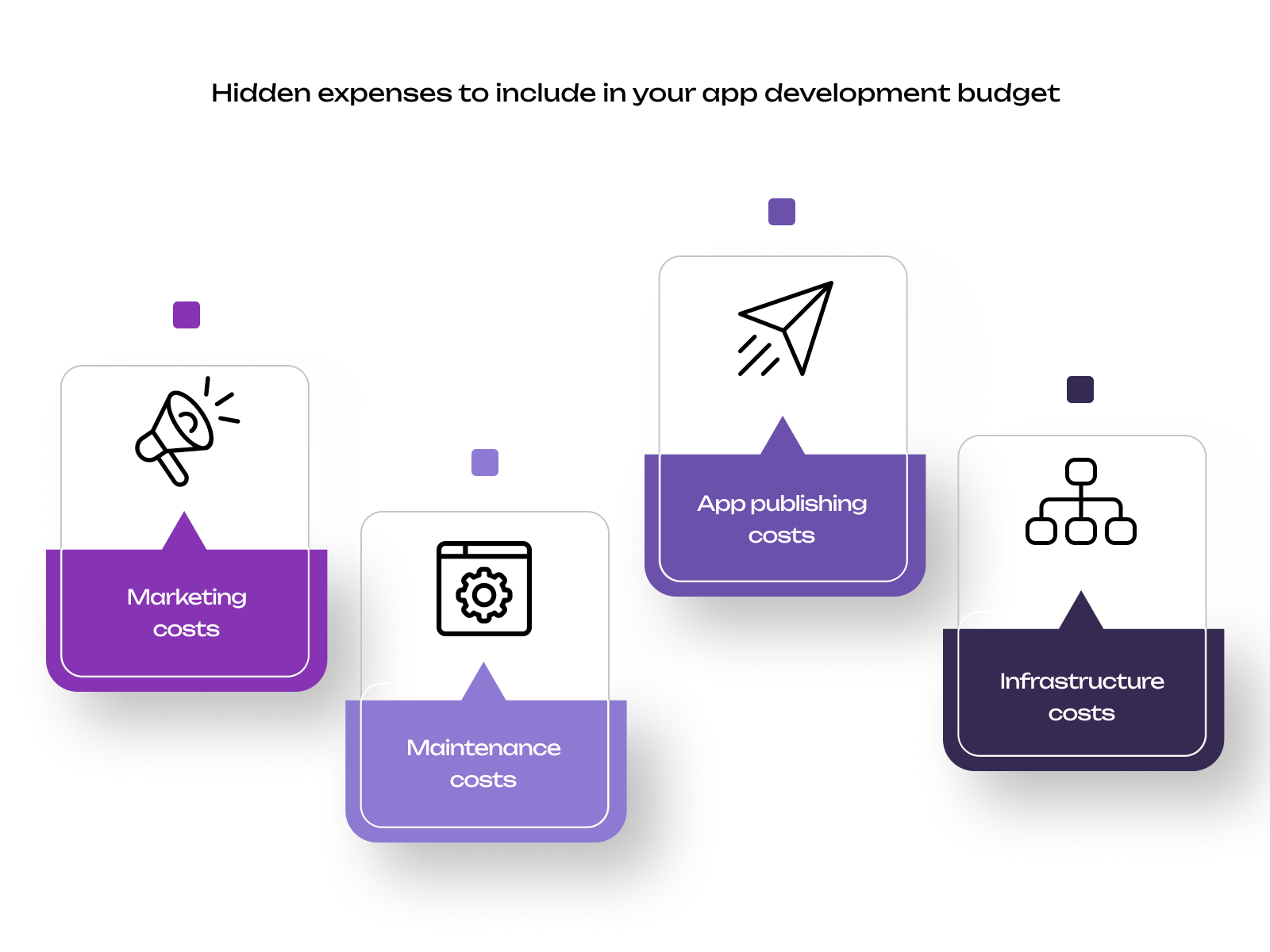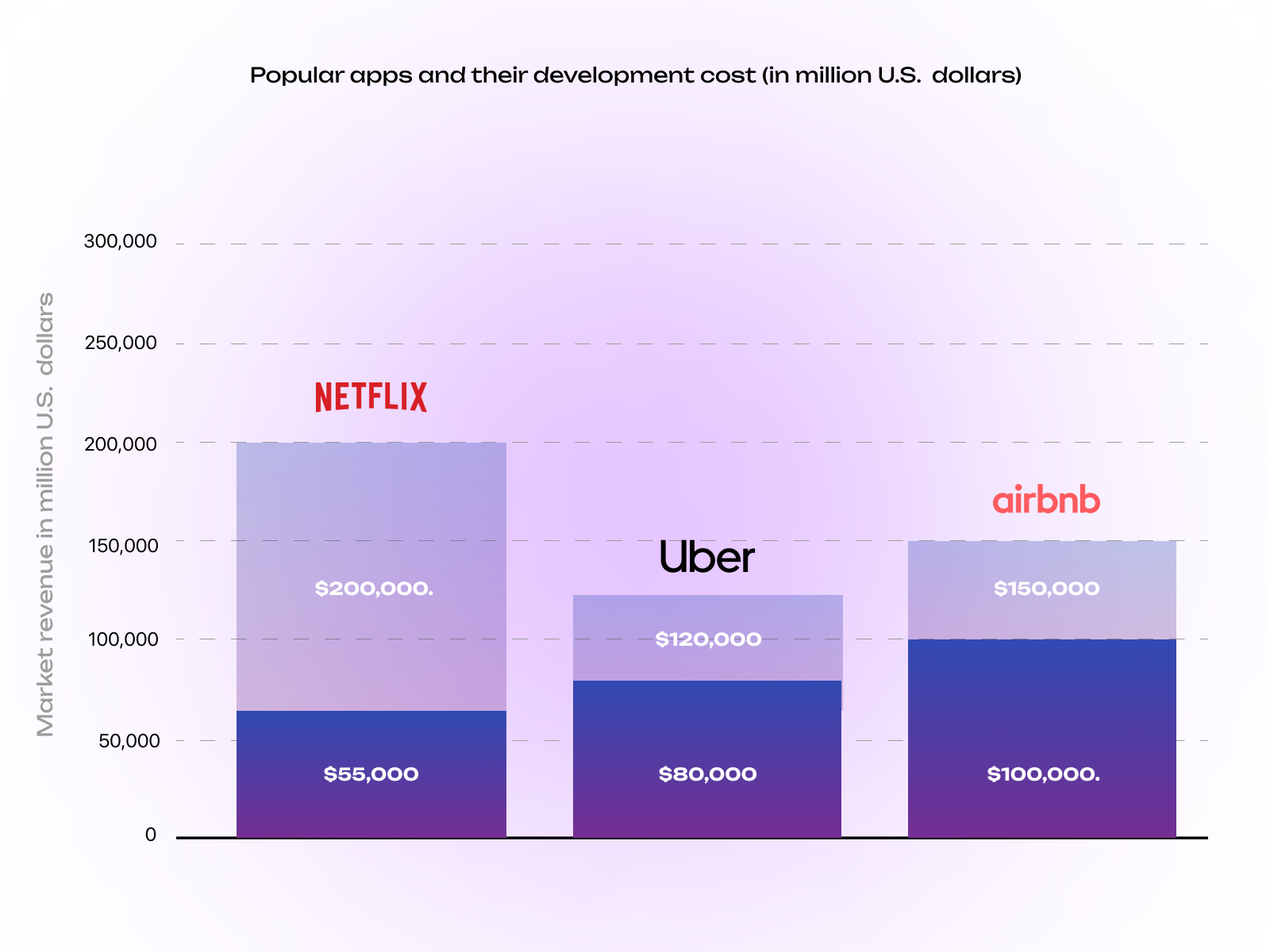App development cost – How much does an app cost? Popular app examples and their costing
The adage “you get what you pay for” is certainly true in developing mobile apps. There is no easy answer to this intriguing question, and most of the time, the answer is “It depends,” which leaves more questions than answers. As a CEO or CIO, you might have many foundational questions. Two queries likely cross your mind: “How much does app development cost?” and “How does the pricing vary?”.
The mobile app development cost can be estimated on various websites you may come across internet, but they are merely marketing ploys to get your attention by asking a few simple questions about your needs. You won’t see the complete picture from the estimation you receive.
In a nutshell, mobile app development can cost anywhere from $40,000 to $500,000. These figures come from market research and studies by renowned platforms like Clutch and GoodFirms.
However, that is a sizable range, right? The truth is that many factors influence how much an app will ultimately cost to develop. This is due to the complexity and wide range of variables involved in app development.
Factors influencing the app development cost
A complete business analysis must be conducted before developing your app to determine what features and functionalities it needs. Many factors influence the overall cost of an app. Let’s examine each of these factors separately:
1. App complexity & features
The complexity and features of the app play a key role in deciding the app development costs. If the functionalities of your app are very complex, the cost of developing it will increase.
The app building cost increases even more with the integration of mainstream APIs and machine learning models. You could believe that adding features like geolocation is simple and affordable; however, using conventional app development techniques, these features are also expensive.
Smaller and simpler mobile apps can be developed quickly on a shoestring budget because they take less time to develop. To establish how much scalability you require in the app architecture, you must consider your future intentions even while creating a modest app. Keep in mind that complicated architecture requires more work and increases the cost of developing an app.
Some of the additional app features which can increase app production cost and time are:
- Real-time chatbots
- Media processing tools
- IoT enabled apps
- AI & Machine learning integrations
2. App platform
Mobile apps can be broadly divided into Native, Web, and Hybrid types.
Native app platform: Native apps provide excellent performance and usability. The native app development tools for each operative system can support updates to the UI and UX. They are accessible via Google Play in addition to the App Store.
If you want your app to have excellent performance and high usability, you should go with native app development. A significant advantage of native apps is their user-friendly user interface and experience. For instance, each platform has a unique collection of buttons, gestures, and swipes.
Web app platform: Web apps’ user interface (UI) is identical to that of a website. They are developed quickly since one code is used for multiple platforms. The web app development frameworks Microsoft Blazer, Native Script, Angular.JS, React, and ionic are among the more well-known ones. Web apps are often created using HTML, CSS, and JavaScript.
Furthermore, it is compatible with a variety of devices. Web applications are slower than native applications, nonetheless, in terms of speed. A hybrid app would respond in 100 milliseconds instead of 10 milliseconds for a native app, for instance.
Hybrid app platform: Hybrid app development, as the name implies, is a cutting-edge method of app development that enables you to make an app that runs on various platforms. While creating a hybrid app, iOS and Android users’ mobile applications are built from the same codebase. The affordable development costs of hybrid apps are one of their benefits.
Xamarine, React Native, Flutter, and many other well-liked hybrid app development tools are available with various frameworks. Compared to native apps, development is simpler and less expensive. Hybrid apps can be the right choice if you need standard usability and a tighter budget. Meanwhile, a sizable user base is supported by hybrid apps as well.
You can read our blog for a detailed comparison between Native vs Web vs Hybrid.
3. UI/UX design
The number of apps available to users is vast. Users are, therefore, likely to abandon an app in favor of a better one if it has a poor UI and UX.
One of the most significant mistakes people make is spending all their money on developing and designing the app’s UI and UX using some off-the-rack tools. The downside of using such tools is that they have limited designs and do not produce unique designs. Also, as these platforms have pre-designed elements, customization is not possible. As a result, all the apps designed using such a platform look alike. We recommend taking UI/UX design seriously and hiring an expert app designer to design your app.
The UX designing costs can be broken down into four components mainly, which are:
- User Research & Analysis
- Information Architecture
- App Navigation
- Wireframing
Typically designing an app costs around $10,000 to $20,000.
4. Backend infrastructure and app administration
Backend infrastructure in mobile app development is an operating system (OS) that provides developers with APIs. These APIs facilitate data exchange between an app and a database. Further, the backend infrastructure allows for assessing your app’s performance and tracking user activity. It is mainly for analytics. The app development cost varies according to the degree of tracking and detailed assessment you need.
It consists of an administration panel for managing your app, users, and statistics. You can create an administration panel according to your business requirements and needs. Such processes enable you to market your app better and also monetize.
5. App Category
The cost of creating an app varies substantially depending on the category. The number of users, functionalities, security standards, and other factors changes as we move from one category to another, eventually resulting in varied app development costs.
Let’s quickly review the most popular categories for developing mobile apps.
E-commerce/M-Commerce apps: Due to their abundant features, eCommerce apps like Amazon and Flipkart are at the height of their popularity. These apps can manage millions of users concurrently, operate effectively in real time, and have strong security.
Costs between $70,000 to $200,000
Social Networking apps: Social networking apps can access hardware features like cameras and audio recorders because they are designed with third-party connections. They are also incredibly scalable because they must support millions of users concurrently. The cost of social networking apps is typically higher than the cost of conventional mobile apps.
Costs between $50,000 to $200,000
On-demand apps: There are three versions of every on-demand application, including the most basic ones: for users, service providers, and businesses. For example, Acti Drive is an on-demand service application based on IoT technology that makes driving easier for drivers.
Costs between $60,000 to $150,000
App Marketplace: Unlike e-commerce apps, a marketplace app provides various services and similar features. In addition to offering multiple services, it swiftly provides the customer’s choice of service providers. The cost of developing a marketplace app might be justified because it is a comprehensive application.
Costs between $70,000 to $160,000
Personalized Apps: Applications that solicit user information fall under this category, including those for food delivery and digital payments. These apps use user data and transmit information between devices.
Costs between $50,000 to $100,000
Why do so many apps fail to succeed?
Although many start-ups have business ideas related to app development, more than 80% fail due to a wrong approach. Though their failure can be easily attributed to a lack of experience, there are many other factors to consider before spending money on or creating mobile apps for your company.
Here are the main reasons why mobile apps fail to succeed:
- The app was not created with the user in mind
- Decision-makers choose the wrong platform
- The application isn’t technologically relevant
- The app has a poor user experience
- Not enough ratings and reviews
- The app isn’t engaging enough
- App testing isn’t extensive enough
You can read all these points in detail in our previous blog: Why Do So Many Apps Fail To Succeed? 7 Major App Failure Reasons & Checklist
Hidden expenses to include in your app development budget
When considering app development cost estimates, you must include the following factors affecting your overall budget. Most businesses fail with their applications because either they ignore these expenses or forget to estimate these beforehand.
Let’s examine each of them in more detail.

1. Marketing costs
Businesses frequently ignore a crucial expenditure pattern like marketing. Every app which is developed needs a marketing plan. Marketing the app does not mean advertising the app, but it includes various other elements:
- Website development cost: The website will be a place where you will launch the app for your existing customers or clients. Designing and developing a website does not cost too much, maybe around $5,000 to $8,000, but still often never estimated beforehand. Hence it becomes a burden for the app owner at the last minute.
- App Advertising: Mobile apps can be advertised on social networks, Youtube channels, app stores, and other relevant websites and platforms. However, this is another expense that is mostly unknown to the app owner and hence avoided in the app development estimates.
- App Promotion: For promotional purposes, the app engagement and marketing cost includes activities that engage a mobile app user base. It is often an overlooked and hidden cost. As much as an app’s development determines its success, its marketing plays an equal role.
2. Maintenance costs
We recommend considering maintenance costs at the beginning of app development. Most app developers include a free maintenance timeframe of up to 3 months of app launch. However, buying an additional maintenance period with the same developer before the app launch is a good idea. The cost of maintaining an app is not too much, maybe around $15,000-$25,000, so discussing this cost before the app launch is always a good idea.
In most cases, app maintenance includes:
- Bug fixing
- Code optimization
- Improving stability and performance
- Support for new OS versions
- Supporting the latest version of third-party services
3. App publishing costs
App store requirements are taken into consideration when developing apps. It’s not all that big in terms of app store costs. A one-time $25 must be paid when submitting your Android app to the Play Store. Alternatively, the Apple store costs $99 a year. You must spend $299 per year to join the Apple Developer Enterprise Program and release your application through the App Store if you only want to distribute it within your company. The service is free on Google Play.
4. Infrastructure costs
Data storage, data delivery, and app hosting are all included in the infrastructure cost. Everything above increases a project’s expense and complexity. Some infrastructure cost elements include servers, development tools, and libraries.
The hosting cost of an app depends on the following:
- Content or app data– whether it is text or media, like photos, videos, or audio
- Number of active users
- Storage needs
Therefore, you should discuss the infrastructure costs and subscriptions beforehand with the app developers to avoid any surprises later.
Popular apps and their development cost
The prominent applications listed below lead the app market and have redefined and revolutionized customer experience. The approximate cost of developing these apps has also been highlighted.

1. Netflix
The top media streaming service in the world is Netflix. Users can stream tv shows and movies whenever it’s convenient for them. Netflix’s market value has been $240 billion since October 2020. If we calculate how much money Netflix makes each month, we can see that its sizable subscriber base—whose monthly subscription fees range from $9.99 to $19.99—is its primary source of revenue.
The Netflix app has the following features:
- Subscription idea
- Payment portal
- Multimedia player
- Screen mirroring
A Netflix-like app typically costs between $55,000 and $200,000.
You might also want to know how to create an app like Netflix.
2. Uber
Uber is a ride-sharing app that links customers with nearby drivers. Although Uber’s initial investment was $510,000, it raised more than $25 billion. Over 118 million people are presently using the app.
The Uber app’s key features include the following:
- Location tracker
- Routing and advanced route optimization
- Authentication and authorization feature
- In-app payment and withdrawal portal
An app like Uber typically costs $80,000-$120,000 to produce and takes around 3-4 months to complete.
3. Airbnb
Airbnb is a mobile application that links renters and individuals looking for lodging nearby for a specific time. From a $20,000 starting investment, Airbnb has grown to a $30 billion valuation. With a 78% year-over-year rise, this business model brought in $6 billion in revenue in 2021.
The Airbnb app has the following features:
- Search field
- In-app chat
- Filters for targeted search
- Listings
A mobile application for Airbnb can take up to 1000 hours to develop and costs over $80,000 – $150,000.
Commonly asked questions related to app development cost
1. How much does it cost to maintain an app?
After the first year, the industry norm for software maintenance is between 15% and 20% of the overall cost of development. This implies that if the development of your mobile app costs $100,000, the annual maintenance costs are likely in the vicinity of $20,000.
2. How much does it cost to update an app?
Updating an app means ensuring it is compatible with the latest iOS and Android versions. Making your app compatible with a new version of iOS won’t cost you a dime. iOS was only problematic once Apple required all developers to convert their software to a 64-bit architecture. When this anomaly appeared, Apple granted developers more than a year to update their programs. Apple also supported 32-bit software for two years before transitioning to the new architecture.
As per Clutch’s survey, your app maintenance budget should be between $10,000 and $14,000.
When it comes to new features such as Face ID, ARKit, Core NFC, etc., that arrive with a new mobile OS version, it’s a different story. Implementing this functionality could cost much more than a dime, depending on how comprehensive the additional capabilities need to be.
3. What are the factors that affect the overall app development costs?
Features and functionalities, the app’s complexity, design and animation, code reusability, size and location of your development team, etc., and other hidden app development considerations determine the app building cost.
4. What is the cost of marketing an app?
The cost of marketing an app depends on your app marketing strategy. Usually, businesses spend 5-15% of their sales turnover on marketing.
Wrapping Up
How much does an app development cost? Well, there isn’t a simple answer to this question. Considering all the influencing aspects, you should be able to estimate the cost of converting your creative app idea into a reality.
If you still think it will be challenging to determine the total cost of developing a mobile application, contact a trustworthy app development company like Markovate for excellent app development services.
The specialists here specialize in creating and releasing the most cutting-edge apps that are scalable and equipped with advanced features and functions. Apps like My Perfect Trainer, Trapeze, Sellvage, Croft, and many others were created and developed by Markovate.
Contact our experts if you intend to develop such cutting-edge mobile apps or if you want to acquire a ballpark estimate for developing an app for your business.
Further Read: Mobile app development process: 6 Key-steps to build your successful app
App development cost: Detailed info-graphic


